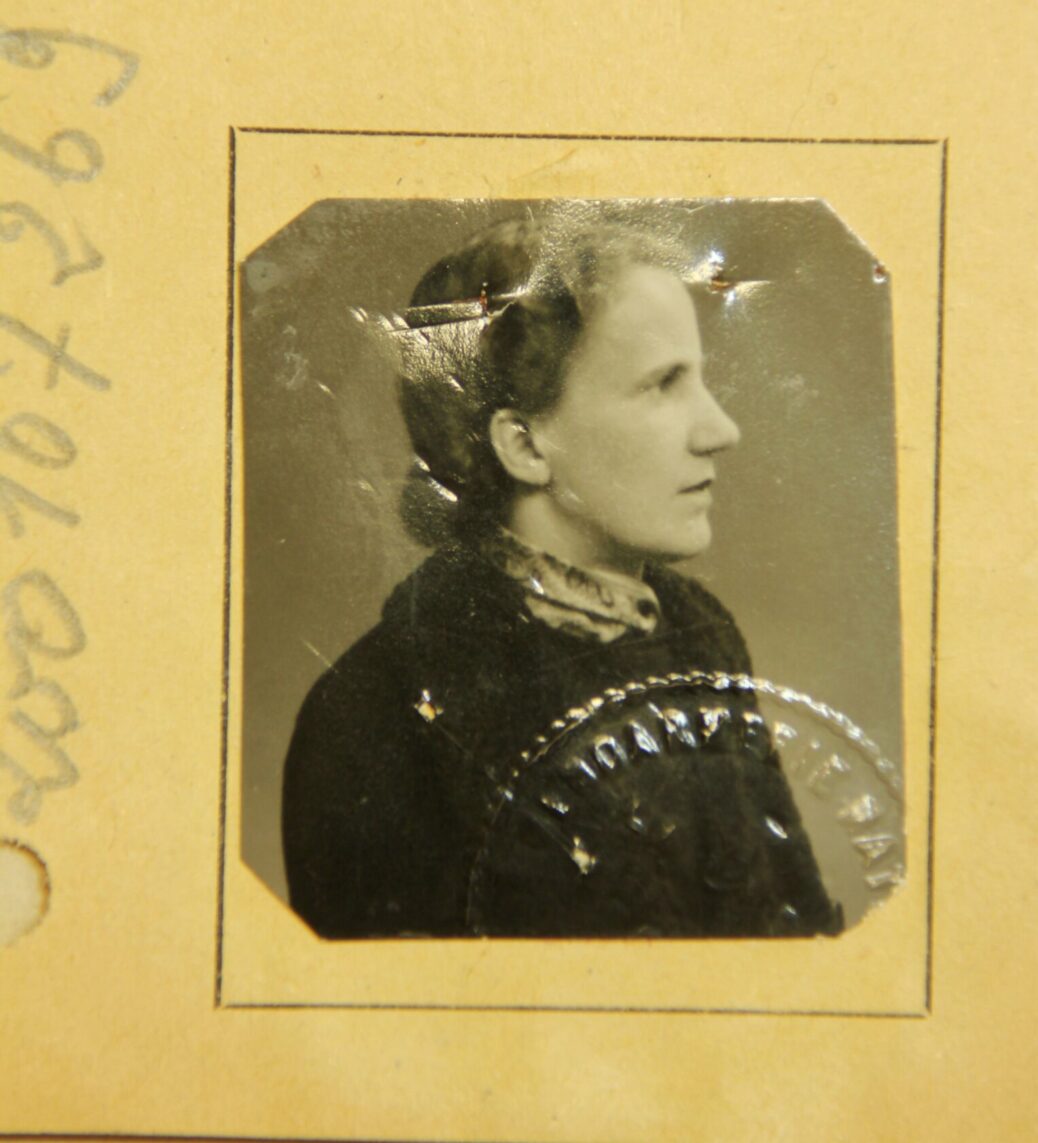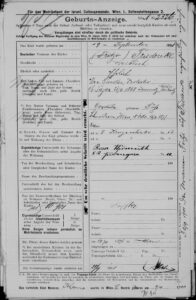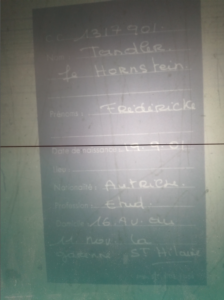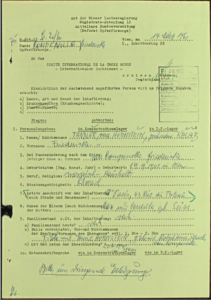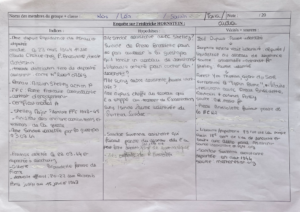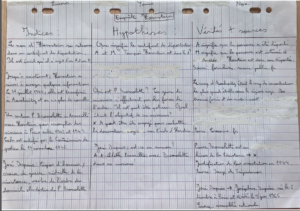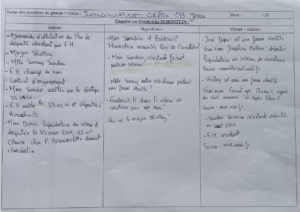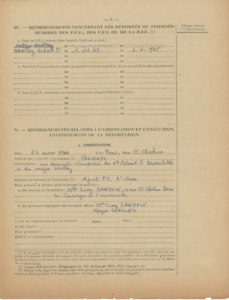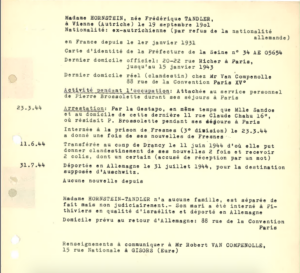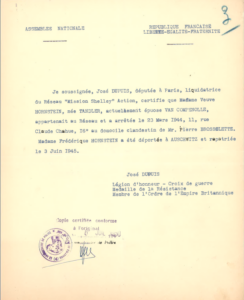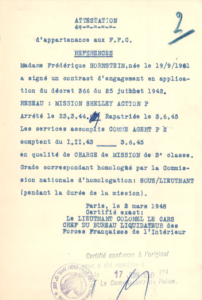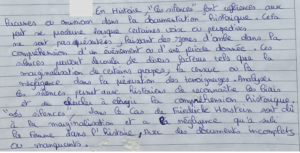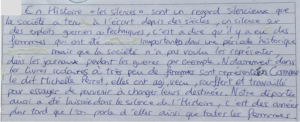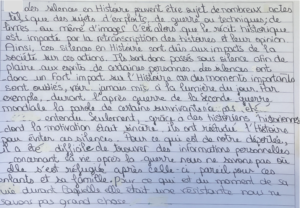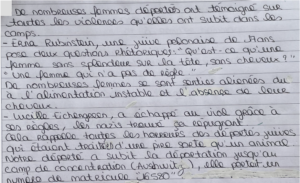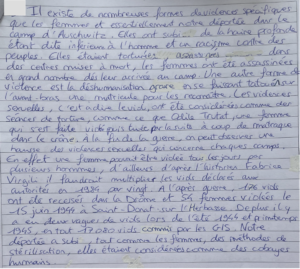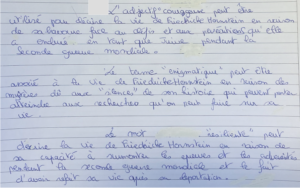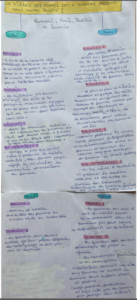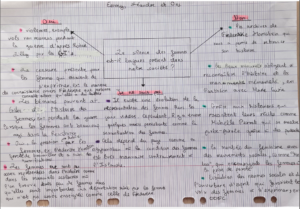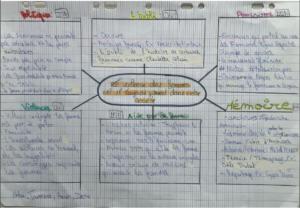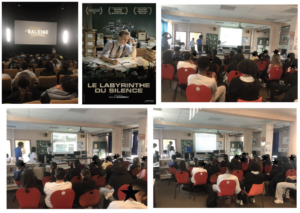Frederike HORNSTEIN
This year, the 11th grade students of class 1B at the Marcel Pagnol high school in Athis-Mons, in the Essonne department of France, set out to answer the following question: “What was it like to be a woman at the time of the extermination process?”
The students carried out a historical investigation in order to write the biography of a woman who was deported on Convoy No. 77: Friédéricke Tandler, Kalab, Hörnstein, Van Compenolle. We were sent two collections of records, the first in November 2023 and the second in April 2024, and worked on them separately. The students split into in groups and then pooled their work:
- I) A historical investigation into the life of Friédéricke Tandler, Kalab, Hornstein, van Compenolle, carried out in in two stages
- II) The historical silences in Friédéricke’s story
- III) Group summaries of the moving debate selected by the students after they had completed the investigation into Friédéricke’s life: “Are women still silenced in contemporary society?”
- IV) Activities to help the students better understand Friédéricke’s life
I) A historical investigation into the life of Friédéricke Tandler, Kalab, Hornstein, Van Compenolle, carried out in in two stages
A) The first file provided by the Convoy 77 team
1) What we know
Friédéricke was born on September 19, 1901, in Vienna, Austria.1 Her parents were Max Tandler and Cordula Suss2.
Official “Birth announcement”, dated May 9, 1900, from the DOW, the Austrian Resistance Documentation Center.
Friédéricke was the widow of Emil Hornstein, was divorced from a man called Kalab and married a Robert Henri Charles von Compenolle in Paris. 3 4 However, the sources differ as to the chronology of these relationships.
Her last known address in Vienna was Schneidergasse 6-8/91 5 . She decided to leave Austria and emigrate to France in January 19316 . She applied for a residence permit for France, which was granted and numbered 1317901. At the time, she was a student living at 16 avenue du 11 novembre, La Garenne, Saint Hilaire, in the Essonne department of France. 7
Application for residence permit for foreigners, file number 328 W, Service for Remembrance and Cultural Affairs, Heritage Department, Archives Section, General Secretariat for Administration, Police Headquarters, undated, by e-mail dated October 6, 2023 in response to a request for information about Friédéricke.
The Gestapo arrested Friédéricke, at the age of 42, in Paris, on March 23, 1944 and interned her in Fresnes prison. She was transferred to Drancy on July 10, 1944, and registered with the serial number 24.969. She was deported to Auschwitz on July 31, 1944 8 on Convoy 77, and later transferred to Kratzau. She was liberated in January 1945 and repatriated to France on June 3, 1945. 9
Card n° 24989, from the Drancy file, from the archives provided by the Convoy 77 team.
In the dossier they sent to us, various addresses are listed:
- When she was arrested, she was living at 43 rue du Poteau in the 18th district of Paris 10 .
- After the war, she first lived in Paris and then by 1945 at 22 route de Trié in Gisors, in the Eure department of France11
- And then at 88 rue de la Convention, with no more detail than that12 .
After the war, she applied to the authorities in Vienna for social welfare for victims 13.
Administrative document produced by the Vienna State Government’s Office for Victim Assistance for the International Committee of the Red Cross, dated March 14, 1961, from the records provided by the Convoy 77 team.
2) Our assumptions and facts, based on online archives
Why did she move to France?
The Anschluss took place in 1938. From March 11 to 13, 1938, the Third Reich implemented an aggressive political strategy and annexed Austria. Nazification of all aspects of Austrian life began. By 1931, however, the Austrian Nazis were gaining supporters. Austrian politics at the time was fraught with infighting and political unrest 14. It was then that Friédéricke decided to move to France 15.
Was she involved in the Resistance?
During an internet search, we found out that Friédéricke worked in secret against the Nazis and joined the Resistance. This record reveals that she was a member of a women’s resistance group, the Forces Françaises Combattantes (FFC). Friédéricke was a member of the internal resistance movement and a victim of Nazi repression (DIR) 16. She is listed on the French website “Mémoire des hommes”17 in a number of categories relating to her resistance activities. Friédéricke’s pseudonym was Freddy Tandelaire. The FFC network to which she belonged was called ACTION P.
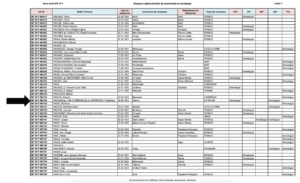
Resistance members’ official files,
French Defense Historical Service / Historical Archives Center, Vincennes
museedelaresistanceenligne.org
Friédéricke is also listed as a witness in Emile Zwiegenthal’s 18 biography on the Convoy 77 website. She testified to the fact that Émile had been a member of the French Resistance and had been deported: “On July 31, 1944, three weeks before the Liberation of Paris, Émile was deported together with his daughter (Marguerite Alt, Osmo, Bojman, whose biography was also written by a class from our high school 19) to the Auschwitz concentration camp aboard Convoy 77. This was also confirmed by Frédérique Van Compenolle (née Tandler) who was also a member of the French Resistance. According to her statement of January 5, 1953, she was on the same convoy as Émile and Marguerite. On the list of deportees, she is listed as Frederike Hornstein.”
What was the actual chronology of her various relationships?
Friédéricke married several times. Her first husband was Josef Kalab, who was born on March 15, 1899 in Hordowitz and lived in Brunn. He was a Roman Catholic. The couple had one child and then separated. It was then that Friédéricke moved to France. Josef died on March 8, 1943 20 in Auschwitz.
After she arrived in France, Friédéricke married Emile Hornstein, who was born on January 27 1899 in Vienna, Austria. Emile’s parents were Jozef Hornstein and Laura née Rosinsohn 21.
Emile was a banker. The couple were living in France when the Third Reich invaded the country. Emile was deported to Auschwitz from the Pithiviers camp on July 17, 1942 on Convoy No. 6, and was executed on August 24, 1942, at the age of 4322 23. Friédéricke stayed on alone in Paris.
What was the Kratzau camp?
Kratzau-Chrastava was an annex camp to the large Gross Rosen camp. The deportees were forced to work in a weapons factory24 .
Memorials to Friédéricke?
Several websites attest to Friédéricke’s Resistance activities. Her name is also inscribed on the Wall of Names at the Shoah Memorial in Paris25 .
B) The second file provided by the Convoy 77 team, from Victims of Contemporary Conflicts Archives Division, ref. AC 21 P 686130
Khîra, Léa, Sarah, Tania and Aïda’s investigation results sheet.
Lucas, Yanis and Noa’s investigation results sheet
Joumana, Aaron, Célia and Jessee’s investigation results sheet.
From the contents of this dossier, we learned more about Friédéricke’s personal life and her Resistance activities.
Friédéricke was living in France on January 1, 1931, when the Seine prefecture issued her an identity card, number 34 AE 05654. Her last official address was at 20-22 rue Richer in Paris, until January 15, 1943, but she actually lived, in secret, with a Mr. Van Compenolle at 88 rue de la Convention in the 15th district of Paris 26.
Friédéricke decided to join the Resistance and took part in the Shelley mission with the Action P group from November 1, 1943 to June 3, 1945 27. The Gestapo arrested her on March 23, 1944 on rue Claude Chahu in Paris, at the safe house where Colonel Pierre Brossolette and Major Shelley were living. This was, she said, “the place where I was involved in the network” 28. At the time, she was a P2 agent, 3rd class. Suny Sandow, the janitor of the building, witnessed the arrest 29.
Friédéricke’s application for the title of deported resistance fighter, page 3, dated November 23, 1950, from the Victims of Contemporary Conflicts Archives Division of the French Ministry of Defense Historical Service archives, ref. AC 21 P 686130.
We also found some additional information about the people mentioned in the report about Friédéricke’s arrest.
Pierre Brossolette was a member of the BCRA (Bureau central de renseignements et d’action, les services secrets de la France Libre, or Central Bureau of Intelligence and Operations, the secret service of Free France). He was arrested on March 19, 1944 and tortured for two and a half days. On March 22, the day before Friédéricke was arrested, he took advantage of the guard’s brief lapse of concentration, got up from his chair, hands still cuffed behind his back, managed to open the window of the former maid’s room where he was being held, fell first onto the 5th floor balcony and then onto the street in front the building. He was seriously injured, and died of his injuries at around 10 p.m that night at the Salpêtrière hospital, without uttering a word 30 .
Suny Sandow was a false name used by Sunneva Sandoe, who was also known as Sunny Sander 31 . Suvenna was born on April 4, 1898 in the Faroe Islands, Denmark 32 . She moved to Paris in the 1930s, began teaching gymnastics and Pierre Brossolette’s children attended her classes. She soon became friends with the family and was of great help to the French Resistance networks during the Occupation. As a result, she was arrested by the Gestapo on March 23, 1944, the same day as Friédéricke. She withstood repeated interrogation and torture, and was deported to Ravensbrück in August 1944. She survived and returned to Denmark after the war 33 . She was later confirmed to have been a member of the women’s resistance group, the Forces Françaises Combattantes (FFC) 34.
Major Shelley was a false name used by Wing Commander Forest Frederick Edward Yeo-Thomas, who was born on June 17, 1902 in London, England. In 1943, Yeo-Thomas, an SOE (Special Operations Executive) agent, nicknamed “le Lapin Blanc” (the White Rabbit)35 was parachuted into France together with Colonel Passy, also known as “Arquebuse”, to meet up with Pierre Brossolette, also known as “Brumaire”, in Paris. His task was to assess the state of the French Resistance. He also used his stay in France to gauge French attitudes towards the Resistance, the French state and its collaboration with the Nazis. When he heard that Pierre Brossolette had been arrested in March 1944, he tried to get permission to go to France to help his friend escape. After parachuting into the country and making a number of contacts, Yeo-Thomas was arrested at the Passy metro station on March 21, after having been betrayed by a liaison officer. He was taken to Fresnes prison, as was Friédéricke two days later, where he was tortured. On July 10, he was listed as one of the prisoners to be deported. After a brief stay in the Compiègne camp, he was deported to Buchenwald on August 8. In early 1945, he was transferred to the main camp at Rehmsdorf, attempted to escape again, and succeeded 36.
Friédéricke was never tried or convicted in a court of law37 . She was interned in Fresnes prison on March 23, 1944, then transferred to the Drancy camp on June 11, 1944, where she managed to send out secret messages twice and receive two parcels, one of which she acknowledged with a note 38. She was deported to Auschwitz from Bobigny station on July 31, 1944. She arrived in Auschwitz on August,1944 where she stayed until she was transferred to Kratzau on October 30, 194439 . She stayed there until the Russian army liberated the camp on May 9, 194540.
In April 1945, Robert Van Compenolle, of 15 rue nationale in Gisors, in the Eure department of France, wrote to Miss Garnier at the French Ministry for Prisoners and Deportees asking for information about Friédéricke43 .
Letter from Robert Van Compenolle, addressed to Miss Garnier at the French Ministry for Prisoners and Deportees, giving and asking for information about Friédéricke, dated April 1, 1945, from the Victims of Contemporary Conflicts Archives Division of the Ministry of Defense Historical Service archives, ref. AC 21 P 686130.
In it, he sent information about his own research. He mentioned the places where Friédéricke had been detained: interned in Fresnes prison, transferred to the Drancy camp and deported to Auschwitz. He was worried about Friédéricke’s state of health and the place “where she was being held with the other internees”. He explained that he had not heard from her since July 31, 1944. He pointed out that Friédéricke had no family and was separated, although not legally, from her husband, who had been interned at Pithiviers and deported to the Third Reich41 42 . His name was Emile Hornstein and he had been deported on Convoy No. 6 to Auschwitz, where he was executed on August 24, 1942 at the age of 43.
After she was repatriated to France, Friédéricke underwent a medical exam organized by the Ministry for Prisoners, Deportees and Refugees. She was 5’1” tall and weighed 92 pounds. She had no infectious diseases or parasites, there was nothing to report with regard to her skin condition or her genitals, her general state of health was deemed to be “average”, and she had lost a total of 22 pounds in weight 53.
Fredericka applied to be naturalized as a French citizen and her request was granted on December 3,1948 44 .
On November 23, 1950, Friédéricke applied for the status of deported resistance fighter. We also know that, at the time she filed her application, she was working in an office 54. She included several testimonies and attestations as proof of her involvement in the Resistance:
- A testimony from José Dupuis, a member of the French National Assembly in Paris and liquidator of the “Mission Shelley” operation, confirmed that Friédéricke was part of the network and was arrested at Pierre Brossolette’s home on March 23, 1944, deported to Auschwitz and repatriated to France on June 3, 1945 45. José Dupuis was a name used by Joséphine Hélène Dupuis. José was born on December 6, 1908 and died on June 9, 1965. She was a member of the French National Assembly from November 10, 1946 to July 4, 1951 46
Testimony of José Dupuis, member of the French National Assembly, liquidator of the ACTION network, attesting to Friédéricke’s participation in the network and that she had been arrested, deported and repatriated to France, dated July 8, 1950, from the Victims of Contemporary Conflicts Archives Division of the Ministry of Defense Historical Service archives, ref. AC 21 P 686130.
- Gilberte Brossolette’s testimony, which confirms that Friédéricke was involved in various operations alongside her husband, Pierre Brossolette 47 .
- A statement signed by Colonel Le Cars, which certified that Friédéricke had signed a contract, in compliance with decree 366 of July 25, 1942, to be part of the Shelley mission with the Action P network, that she had been arrested on March 23, 1944, and that she had been repatriated on June 3, 1945. Friédéricke served as a P2 agent from November 1, 1943 to June 3, 1943, as a senior mission officer, 3rd class, a rank recognized by the national certification commission as the equivalent of Second-Lieutenant 48.
Statement by Lieutenant-Colonel Le Cars, head of the liquidation office of the Forces Françaises de l’Intérieur (French Interior Forces), authenticating Friédéricke’s contract of enlistment, her activities as a P2 agent, her arrest and repatriation, dated March 2, 1948, from the Victims of Contemporary Conflicts Archives Division of the Ministry of Defense Historical Service archives, ref. 21 P 686130.
- A statement, certified by Captain Liger, officer in charge of the liquidation of France Combattante (formerly France Libre, or Free France), and Second-Lieutenant Sellier, which confirmed that the Action Network was a Franco-British operation and listed a different signature date for Friédéricke’s enlistment contract.
Friédéricke was granted the status of deported resistance fighter on November 19, 195150 . She held a “Model A” certificate. The letter A means that Friédéricke was interned, deported and survived 51. She received her card, number 2001.07269 on December 17 1951 52.
II) The historical silences in Friédéricke’s story
1) What does the term “historical silences” mean?
Replies in French:
Group comprising Kaïs, Terry, Rayan, Léandre and Sami:
Group comprising Khîra, Emmy, Ons et Mohamed:
Group comprising Aida, Tania, Léa and Sarah:
2) What specific types of violence did Friédéricke experience?
Replies in French:
Group comprising Flavie, Yannis, Kalani and Noa:
Group comprising Khîra, Emmy, Ons and Mohamed:
3) How does your work contribute to keeping the memory of the deportation, and of Friédéricke, alive?
Replies in French:
Group comprising Joumana, Dana, Aaron and Célia:
Group comprising Aïda, Tania, Léa and Sarah:
4) Can you list some adjectives to describe Friédéricke’s life?
Replies in French:
Group comprising Kamelia, Lucas, Annie, Jasmine and Laetitia:
Group comprising Kaïs, Terry, Rayan, Léandre and Sami:
Sources that the students were able to use to help them answer the questions (in French)
- Titiou LECOQ, Les grandes oubliées : Pourquoi l’Histoire a effacé les femmes , l’Iconoclaste, Paris, 2021. Chapitre 15 : Deuxième Guerre mondiale : le rôle des femmes minimisé.
- Michelle PERROT, Les femmes ou les silences de l’Histoire, Flammarion, Paris, 2020. Quatrième de couverture.
- Association MNEMOSYNE, Coordination Geneviève DERMENJIAN, Irène JAMI, Annie ROUQUIER, Françoise THEBAUD, La place des femmes dans l’histoire, une histoire mixte , Belin, Paris, 2010. Chapitre : Femmes et hommes dans les guerres, les démocraties et les totalitarismes (1914-1945).
- Simone de BEAUVOIR, Le deuxième sexe, Tome I, Gallimard, Paris, 1949. Quatrième de couverture.
- Jo-Ann OWUSU, Les menstruations et l’holocauste, History Today, numéro 69, mis en ligne le 5 mai 2019.
- https://www.historytoday.com/archive/feature/menstruation-and-holocaust
- Isabelle ERNOT, Le genre en guerre. « Exécutrices, victimes, témoins », Genre & Histoire, numéro 15, mis en ligne le 30 septembre 2015.
- https://journals.openedition.org/genrehistoire/2218
- Isabelle ERNOT, Le genre en guerre : « Les femmes et/dans l’Holocauste » : à la croisée des Women’s-Gender et Holocaust Studies (Années 1980-2010) », Genre & Histoire, numéro 15, mis en ligne le 30 septembre 2015 .
- http://journals.openedition.org/genrehistoire/2223
- Elissa Mailänder, « Des femmes allemandes au service de la guerre : participations actives aux politiques raciales nationales-socialistes, à la déportation et au génocide (1939-1945) », Genre & Histoire, 15 | Automne 2014-Printemps 2015, mis en ligne le 30 septembre 2015.
- https://journals.openedition.org/genrehistoire/2202
III) Group summaries (in French) of the moving debate selected by the students after they had completed the investigation into Friédéricke’s life: “Are women still silenced in contemporary society?”
Mind map by the group comprising Annie, Kamelia, Laetitia and Jasmine.
Mind map by the group comprising Emmy, Léandre and Ons.
Mind map by the group comprising Célia, Joumana, Aaron and Dana.
IV) Other activities to help the students better understand Friédéricke’s life
In order to gain a better insight into Friedericke’s life, the students watched Giulio Ricciarelli’s film, Le labyrinthe du Silence (The Labyrinth of Silence), released in 2014 at the La Baleine cinema in Marseille, France.
Also, students from the 12th year HGGSP1 class, who have become the school’s “passeurs de Mémoire” (Memory ambassadors), presented their historical investigation into the life of Henriette Cohen and their account of the network of memorial sites they used to retrace Henriette’s path, including their field trip to Auschwitz-Birkenau in January 2024. Their summary, in French, is available here on padlet.
Poster source: allocine.fr
Sources
1 Official document “Demande de recherche” (“Request for research”) issued by the Ministry of Veterans and Victims of War to the head of the French liaison mission to the Arolsen International Research Service, dated August 1, 1961, from the archives provided by the Convoy 77 non-profit organization; official document “Annonce de naissance” (“Birth announcement”) dated May 9, 1900, from the DOW, Austrian Resistance Documentation Center; and official document “Livre de naissance” (“Birth record”), line 2326, undated, also from the DOW Austrian Resistance Documentation Center.
2 Information card for Friédéricke containing personal details, dates and places where she was detained, undated, from the records provided by the Convoy 77 non-profit organization.
3 Official document “Demande de recherche” (“Request for research”) produced by the Ministry of Veterans’ Affairs and Victims of War for the Head of the French Liaison Mission to the Arolsen International Research Service, dated August 1, 1961, from the archives provided by the Convoy 77 non-profit organization and Official document produced by the Vienna State Government’s Office for Victim Assistance for the International Committee of the Red Cross, dated March 14, 1961, from the records provided by the Convoy 77 non-profit organization.
4 Official document issued by the Vienna State Government’s Office for Victim Support to the International Committee of the Red Cross, dated March 14, 1961, from the records provided by the Convoy 77 non-profit organization.
5 Information provided by Wolfgang Schellenbacher Dokumentationsarchiv des österreichischen Widerstandes (DÖW) Wipplingerstraße 6-8, A-1010 Vienna, email dated October 6, 2023 in response to a request for information about Frédéricke.
6 Official document issued by the Vienna State Government’s Office for Victim Support to the International Committee of the Red Cross, dated March 14, 1961, from the records provided by the Convoy 77 non-profit organization.
7 File of applications for residence permits for foreigners, file number 328 W, Office of Memory and Cultural Affairs, Heritage Department, Archives Section, Secretary General for Administration, Police Headquarters, undated, email dated October 6, 2023 in response to a request for information about Friédéricke.
8 Record card from the Drancy file, n° 24989, undated, from the records provided by the Convoy 77 non-profit organization.
9 Information card for Friédéricke containing personal details, dates and places of detention, undated, from the records provided by the Convoy 77 non-profit organization and an official document produced by the Vienna State Government’s Office for Victim Support for the International Committee of the Red Cross, dated March 14, 1961, from the records provided by the Convoy 77 non-profit organization.
10 Official document issued by the Vienna State Government’s Office for Victim Assistance to the International Committee of the Red Cross, dated March 14, 1961, from the records provided by the Convoy 77 non-profit organization.
11 Information card for Friédéricke containing personal details, dates and places of detention, undated, from the records provided by the Convoy 77 non-profit organization.
12 Incomplete document with photo of Frédéricke and some personal information about her, undated, from the records provided by the Convoy 77 non-profit organization.
13 Information provided by Wolfgang Schellenbacher Dokumentationsarchiv des österreichischen Widerstandes (DÖW) Wipplingerstraße 6-8, A-1010 Vienna, email dated October 6, 2023 in response to a request for information about Frédéricke.
14 https://encyclopedia.ushmm.org/content/fr/article/nazi-territorial-aggression-the-anschluss
15 Official document produced by the Vienna State Government’s Office for Victim Support for the International Committee of the Red Cross, dated March 14, 1961, from the records provided by the Convoy 77 non-profit organization.
16 https://www.museedelaresistanceenligne.org/musee/doc/pdf/ressource_source/SHDGR_16P_T.pdf
17 https://www.memoiredeshommes.sga.defense.gouv.fr/fr/arkotheque/client/mdh/recherche_transversale/bases_nominatives_detail_fiche.php?fonds_cle=24&ref=2716552&debut=0
18 https://convoi77.org/deporte_bio/emile-zweigenthal/
19 https://convoi77.org/deporte_bio/margarete-alt/
20 https://www.ushmm.org/online/hsv/person_view.php?PersonId=12499806
21 https://collections.yadvashem.org/en/names/5389905
22 https://ressources.memorialdelashoah.org/notice.php?q=hornstein&spec_expand=1&start=14
23 https://www.doew.at/result
24 https://fondationmemoiredeportation.com/wp-content/uploads/2015/02/memoire_vivante46-1.pdf
25 https://ressources.memorialdelashoah.org/notice.php?q=hornstein&spec_expand=1&start=2
26 Letter from Robert Van Compenolle to Miss Garnier of the French Ministry of Prisoners and Deportees, providing and requesting information about Friédéricke’s deportation, dated April 1, 1945, from the DAVCC (Victims of Contemporary Conflicts Archives Division of the Ministry of Defense Historical Service) archives, ref. AC 21 P 686130.
27 Friédéricke’s application for the status of deported resistance fighter, page 2, dated November 23, 1950, from the DAVCC (Victims of Contemporary Conflicts Archives Division of the Ministry of Defense Historical Service) archives, ref. AC 21 P 686130.
28 Friédéricke’s application for the status of deported resistance fighter, page 5, dated November 23, 1950, from the DAVCC (Victims of Contemporary Conflicts Archives Division of the Ministry of Defense Historical Service) archives, ref. AC 21 P 686130.
29 Friédéricke’s application for the status of deported resistance fighter, page 3, dated November 23, 1950, from the DAVCC (Victims of Contemporary Conflicts Archives Division of the Ministry of Defense Historical Service) archives, ref. AC 21 P 686130.
3O https://www.pierrebrossolette.com/biographie-de-pierre-brossolette/
31 https://fr.wikipedia.org/wiki/Yvonne_Baratte
32 https://www.museedelaresistanceenligne.org/musee/doc/pdf/ressource_source/SHDGR_16P_S.pdf
33 https://www.memoresist.org/résistant/suvenna-sandoe/
34 https://www.museedelaresistanceenligne.org/musee/doc/pdf/ressource_source/SHDGR_16P_S.pdf
35 http://mvr.asso.fr/front_office/fiche.php?idFiche=107&TypeFiche=3
36 https://museedelaresistanceenligne.org/media2932-Forest-Frederick-Yeo-Thomas
37 Friédéricke’s application for the status of deported resistance fighter, page 3, dated November 23, 1950, from the DAVCC (Victims of Contemporary Conflicts Archives Division of the Ministry of Defense Historical Service) archives, ref. AC 21 P 686130.
38 Letter from Robert Van Compenolle to Miss Garnier of the French Ministry of Prisoners and Deportees, providing and requesting information about Friédéricke’s deportation, dated April 1, 1945, from the DAVCC (Victims of Contemporary Conflicts Archives Division of the Ministry of Defense Historical Service) archives, ref. AC 21 P 686130.
39 Friédéricke’s application for the status of deported resistance fighter, page 4, dated November 23, 1950, from the DAVCC (Victims of Contemporary Conflicts Archives Division of the Ministry of Defense Historical Service) archives, ref. AC 21 P 686130.
4O Friédéricke’s application for the status of deported resistance fighter, page 5, dated November 23, 1950, from the DAVCC (Victims of Contemporary Conflicts Archives Division of the Ministry of Defense Historical Service) archives, ref. AC 21 P 686130.
41 https://ressources.memorialdelashoah.org/notice.php?q=hornstein&spec_expand=1&start=14
42 https://www.doew.at/result
43Letter from Robert Van Compenolle to Miss Garnier of the French Ministry of Prisoners and Deportees, providing and requesting information about Friédéricke’s deportation, dated April 1, 1945, from the DAVCC (Victims of Contemporary Conflicts Archives Division of the Ministry of Defense Historical Service) archives, ref. AC 21 P 686130.
44 Official document attesting to Friédéricke having been naturalized as a French citizen on December 3, 1948 by Emmanuel Rain, Director General of Population and Assistance, undated, from the DAVCC (Victims of Contemporary Conflicts Archives Division of the Ministry of Defense Historical Service) archives, ref. AC 21 P 686130.
45 Testimony of José Dupuis, member of the French National Assembly, liquidator of the ACTION network, attesting to Friédéricke’s participation in the network and that she had been arrested, deported and repatriated to France, dated July 8, 1950, from the DAVCC (Victims of Contemporary Conflicts Archives Division of the Ministry of Defense Historical Service) archives, ref. AC 21 P 686130.
46 https://www2.assemblee-nationale.fr/sycomore/fiche/(num_dept)/2734
47 Gilberte Brossolette’s testimony, which confirms that Friédéricke was involved in various operations alongside her husband, Pierre Brossolette, dated October 24, 1945, from the DAVCC (Victims of Contemporary Conflicts Archives Division of the Ministry of Defense Historical Service) archives, ref. AC 21 P 686130.
48 Statement by Lieutenant-Colonel Le CARS, head of the liquidation office of the Forces Françaises de l’Intérieur (French Interior Forces), verifying Friédéricke’s contract of enlistment, her work as a P2 agent and her arrest and repatriation, dated March 2, 1948, from the DAVCC (Victims of Contemporary Conflicts Archives Division of the Ministry of Defense Historical Service) archives, ref. AC 21 P 686130.
49 Certificate from Captain Ligier, head of the “France combattante” (formerly France Libre, or Free France) service, confirming Friédéricke’s involvement in the ACTION network., dated November 8, 1945, from the DAVCC (Victims of Contemporary Conflicts Archives Division of the Ministry of Defense Historical Service) archives, ref. AC 21 P 686130.
5O Review sheet, Office for the status of Resistance deportees & internees relating to Friédéricke’s application to be granted the status of deported resistance fighter, including the final decision to grant her the status, drawn up by the head of the service, dated November 23, 1951, from the DAVCC (Victims of Contemporary Conflicts Archives Division of the Ministry of Defense Historical Service) archives, ref. AC 21 P 686130.
51 https://www.legifrance.gouv.fr/codes/id/LEGIARTI000021635422/2010-01-01
52 Letter to Friédéricke from the French Ministry of Veterans and Victims of War, granting her the title of deported Resistance fighter and card no. 2001.07269, dated December 17, 1951, from the DAVCC (Victims of Contemporary Conflicts Archives Division of the Ministry of Defense Historical Service) archives, ref. AC 21 P 686130.
53 Medical file with Friédéricke’s personal details and medical examination report, produced by the Ministry of Prisoners, Deportees and Refugees, undated, from the DAVCC (Victims of Contemporary Conflicts Archives Division of the Ministry of Defense Historical Service) archives, ref. AC 21 P 686130.
54 Friédéricke’s application for the status of deported resistance fighter, Page 1, dated November 23, 1950, from the DAVCC (Victims of Contemporary Conflicts Archives Division of the Ministry of Defense Historical Service) archives, ref. AC 21 P 686130.


 Français
Français Polski
Polski